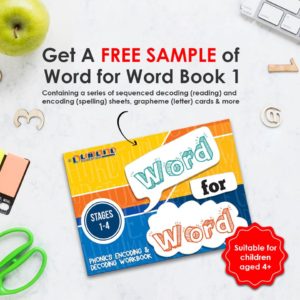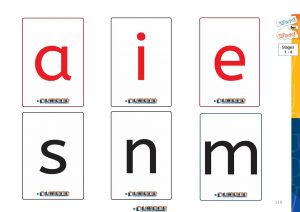Education, Word for Word
Using your FREE Word for Word (Stages 1-4) Download
Yesterday’s Facebook post has been extremely popular and we would like to thank you all for the phenomenal interest you have shown in Word for Word.

I thought it may be helpful to provide a little more guidance on using some of the materials in your free sample, beginning with the grapheme (letter) cards.

In Word for Word, we advocate teaching phonemes (sounds) in a structured way. As such, we have divided the sounds into stages. The content of each stage builds on the previous one. Your free download contains all of the graphemes (letters) of stage 1.
Our Word for Word (Stages 1 – 4) book outlines in detail how to teach each of these sounds and then explains how to introduce blending and segmenting with them. Once your child knows at least 2 sounds (one consonant [C] and one vowel [V]), they will begin blending at CV (consonant – vowel) and the VC (vowel – consonant_ level).
Blending involves combining individual sounds, e.g.
/m/ + /a/ = /ma/ or /a/ + /m/ = /am/.
The slash marks are used to indicate the sound of. As well as being able to put the 2 sounds together and tell you the answer verbally, your child should be able to show you this using their grapheme (letter) cards.
One children can do this, they will practise segmenting. Segmenting involves breaking sounds into their component parts and is a crucial spelling skill. In the example above, when you say /ma/, your child should be able to tell you /ma/ is made up of /m/ and /a/. Furthermore, they should be able to represent the 2 sounds using their grapheme (letter) cards.
It is useful to consider the number of CV and VC sounds your child can learn to blend and segment using only the grapheme cards in your free download.
sa, se, si,
na, ne, ni,
ma, me, mi,
as, es, is
an, en, in,
am, em, im
Please note: When teaching the stage one sounds, we teach short vowel sounds only and do not concern ourselves with real words for now. For example, children will learn /e/ as in egg and will blend /m/ + /e/ to form /me/ as in met, rather than the real word. Children will learn how to read the real word ‘me’ when they learn about open and closed syllables in stage 6. Similarly, with ‘as’ and ‘is,’ children will learn to read them as the components of longer words /as/ as in pass and /is/ as in hiss rather than with a /z/ ending. They will later learn that s can represent /z/.
Once children can confidently blend and segment at CV and VC level, they will apply their skills to CVC (consonant – vowel – consonant) words and thus can form,
san, sen, sin,
sam, sem, sim,
nam, nem, nim,
nas, nes, nis,
man, men, min,
mas, mes, mis
Printing a second copy of the grapheme cards, such that you have 2 of each consonant, provides even more options,
nan, nen, nin,
mam, mem, mim,
sas, ses, sis.
One of the questions I have been asked about Word for Word is why blend and segment “nonsense” sounds and is doing so a waste of time. The answer to this is an emphatic no. Such blending and segmenting is most definitely not a waste of time. In fact, it is a crucial step in the reading process. Although what we can blend with the first six grapheme cards may be perceived as nonsense, the CV, VC and CVC sounds we can create are regularly found in the larger words our children will later encounter.
Let’s examine this further. You may wish to use this as a personal word challenge! Can you think of a longer word containing the following syllables? For example,
san – sandwich
sen – sentence
sin – sinister
Remember the syllable can be anywhere in the word.
san – diocesan
sen – worsen
sin – insincere
Try for yourself! You may wish to time yourself for this word challenge.
sam, sem, sim,
nam, nem, nim,
nas, nes, nis,
man, men, min,
mas, mes, mis,
nan, nen, nin,
mam, mem, mim,
sas, ses, sis.
This also makes a great challenge for older children. When introducing it, you may wish to use the 2-letter sounds with them. For example, can you think of words containing sa, se and si? (Sand, sell, sit).
Try it with the other sounds:
na, ne, ni,
ma, me, mi,
as, es, is
an, en, in,
am, em, im
I hope this post has been helpful in supporting you to use our Word for Word grapheme cards with your child. Moreover, I hope you can see the rationale behind the use of nonsense syllables and how this supports reading acquisition.
Although you may be tempted to create CVCe words (e.g., same, name, mane etc.) using the grapheme cards, please avoid this temptation if your child is a beginner. Rest assured, we at Dumond have thought carefully about their introduction and you will find these split digraph (or “magic e”) words introduced in Word for Word stage 5 (Book 2).
Phonics teaching should be explicit and systematic as this enables children to make connections between the sound patterns they hear in words and the way these words are written. Word for Word enables you to teach your child in the explicit, systematic way that is the foundation for later reading, writing and spelling success.
How did you do on the challenge above? Did you enjoy it? Here are my words.
sam, sem, sim – flotsam, semblance, simple
nam, nem, nim – tsunami, mnemonic, nimble
nas, nes, nis – nasty, business, furnish
man, men, min – manage, mentor, minute
mas, mes, mis – masterpiece, message, missive
nan, nen, nin – banana, opponent, serotonin
mam, mem, mim – mammal, memory, mimic
sas, ses, sis – sassy, molasses, sister.
FREE SAMPLE: Word for Word (Stages 1 – 4) Available here
